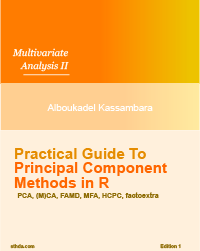Logiciel web de calcul du coefficient de corrélation
Le test de corr?lation est utilis? pour ?tudier la d?pendance entre deux ou plusieurs variables. Le but de cet article est de d?crire bri?vement les diff?rentes m?thodes de corr?lation et de fournir un calculateur de coefficient de corr?lation en ligne.
Les diff?rents types de corr?lations
Il existe :
- la m?thode de corr?lation de Pearson qui est un test de corr?lation param?trique car elle d?pend de la distribution des donn?es. Cette m?thode mesure la d?pendance lin?aire entre les deux variables.
- le test de corr?lation de Kendall et celui de Spearman bas?s sur un test de rang (m?thodes non param?triques). Ces deux m?thodes sont recommand?es si les donn?es ne proviennent pas d?une distribution normale.
Le test de corr?lation de Pearson est la m?thode, la plus couramment utilis?e pour calculer le coefficient de corr?lation entre deux variables. La formule est montr?e dans la section suivante.

Formule du coefficient de corr?lation de Pearson
Le coefficient de corr?lation de Pearson entre deux variables x et y, peut ?tre calcul? en utilisant la formule ci-dessous:
\[ r = \frac{\sum{(x-m_x)(y-m_y)}}{\sqrt{\sum{(x-mx)^2}\sum{(y-my)^2}}} \]
\(m_x\) et \(m_y\) correspondent aux moyennes des variables x et y.
Le niveau de significativit? de la corr?lation peut ?tre d?termin? en lisant la table des valeurs critiques pour un degr? de libert? : \(dl = n-2\)
Lire plus : Formule du coefficient de correlation
Calculer le coefficient de corr?lation en utilisant le logiciel R
Le coefficient de corr?lation peut ?tre facilement calcul? en utilisant la fonction R cor() ou cor.test(). Les formats simplifi?es sont:
cor(x, y, method = c("pearson", "kendall", "spearman"))
cor.test(x, y, method=c("pearson", "kendall", "spearman"))Dans le code R ci-dessus, x et y sont deux vecteurs num?riques de m?me longueur.
La principale diff?rence entre les deux fonctions de calcul de corr?lation est la suivante:
- la fonction cor() renvoie uniquement le coefficient de corr?lation
- la fonction cor.test() retourne ? la fois le coefficient de corr?lation et le niveau de significativit? (ou p-value) de la corr?lation.
Ces fonctions peuvent ?tre utilis?es comme suit:
# D?finir deux vecteurs num?riques
x <- c(44.4, 45.9, 41.9, 53.3, 44.7, 44.1, 50.7, 45.2, 60.1)
y <- c( 2.6, 3.1, 2.5, 5.0, 3.6, 4.0, 5.2, 2.8, 3.8)
# Coefficient de corr?lation de Pearson entre x et y
cor(x, y)[1] 0.5712# Test de corr?lation de pearson
cor.test(x, y)
Pearson's product-moment correlation
data: x and y
t = 1.841, df = 7, p-value = 0.1082
alternative hypothesis: true correlation is not equal to 0
95 percent confidence interval:
-0.1497 0.8956
sample estimates:
cor
0.5712 Le coefficient de corr?lation est 0.5712 et la p-value est 0.1082.
Lire plus : Test de corr?lation entre deux variables dans R
Les m?thodes non-param?triques de Spearman et de Kendall peuvent ?tre utilis?es comme suit :
# Test de corr?lation non-param?trique de Spearman
cor.test(x, y, method="spearman")
# Test de corr?lation non-param?trique de Kendall
cor.test(x, y, method="kendall")Interpr?tation du coefficient de corr?lation
La valeur du coefficient de corr?lation est comprise entre -1 et 1



- -1 correspond ? une forte corr?lation n?gative: cela signifie que, chaque fois que x augmente, y diminue (figure de gauche)
- 0 signifie qu?il n?y a pas d?association entre les deux variables (x et y) (figure du milieu)
- 1 correspond ? une forte corr?lation positive: cela signifie que, y augmente avec x (figure de droite)
Logiciel web de calcul du coefficient de corr?lation
Une application web, pour le calcul des diff?rents coefficients de corr?lation, est disponible ? ce lien: calculateur de coefficients de corr?lation.
Il peut ?tre utilis? en ligne sans aucune installation pour calculer les coefficients de corr?lation de Pearson, de Kendall et de Spearman.
Accedez au logiciel de calcul du coefficient de corr?lation
Le logiciel peut ?tre utilis? comme suit:
- Acc?dez ? l?application disponible ? ce lien: calculateur de coefficients de corr?lation
- Copiez et collez vos donn?es d?Excel vers le logiciel web. Vous pouvez ?galement utiliser les donn?es de d?mo qui sont disponibles sur la page Web du logiciel en cliquant sur le lien correspondant.
- S?lectionnez les m?thodes de corr?lation (Pearson, Spearman ou de Kendall). Par d?faut, la m?thode de Pearson est choisie.
- Cliquez sur le bouton OK
Notez que, vous pouvez sp?cifier l?hypoth?se alternative ? utiliser pour le test de corr?lation en cliquant sur le bouton ?Options avanc?es?.
Choisissez l?une des 3 options:
- Two-sided pour un test bilat?ral
- Corr?lation <0 pour un test unilat?ral inf?rieur
- Corr?lation > 0 pour un test unilat?ral sup?rieur
Show me some love with the like buttons below... Thank you and please don't forget to share and comment below!!
Montrez-moi un peu d'amour avec les like ci-dessous ... Merci et n'oubliez pas, s'il vous plaît, de partager et de commenter ci-dessous!
Recommended for You!
Click to follow us on Facebook:
Comment this article by clicking on "Discussion" button (top-right position of this page)








